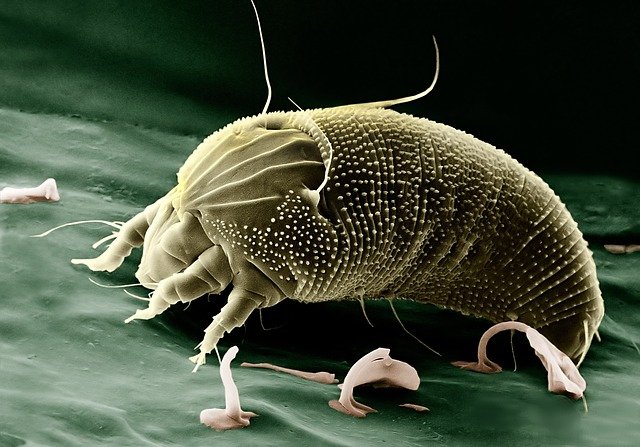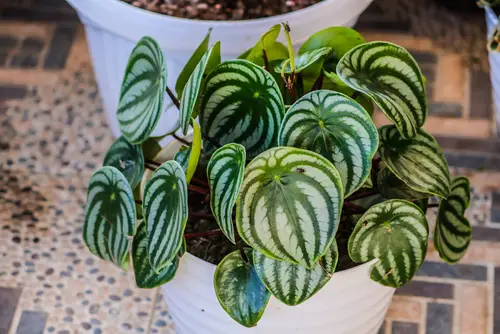The watermelon peperomia lightens the mood of any setting and welcomes everyone with warmth. So, it is sad to notice the watermelon peperomia leaves curling. Most plant parents wonder why this happens to their beautiful watermelon peperomia plant.
The causes of watermelon peperomia leaves curling are plant exposure to extreme conditions, pest infestation, infection, and poor plant management.
This article answers questions and concerns on watermelon peperomia leaves curling. It also guides the plant parents on ways to avoid rookie mistakes that cause wilting of the watermelon peperomia leaves. With proper care and attention, the watermelon peperomia can flourish and brighten any space it is placed in.
Fun Facts
Why are watermelon peperomias favorites of houseplant parents? Let’s find out:
- These exciting plants are close relatives of the black pepper (Piper nigrum)
- Watermelon peperomia plants are so-called due to their characteristic leaf pattern that resembles the watermelon rind
- They are short plants and grow about 35cm high. This makes them suitable for all surfaces in the home
- They have detoxification and blood cleansing properties
- Watermelon peperomias dislike direct sunlight. This makes them perfect houseplants
- They are not needy plants. So, they fit into inflexible plant parent schedules.
- Its botanical name, Peperomia argyreia, stems from the Greek word, “Argyros.” Argyros means silver and refers to the shimmer of the watermelon peperomia leaves.
Common Causes of Watermelon Peperomia Leaves Curling
These exotic plants shimmer when happy and curl up when sad. Here are a few causes of watermelon peperomia leaves curling and helpful management tips:
1. Exposure to Direct Sunlight

This is a significant cause of watermelon peperomia leaves curling. On hot, sunny days, we sweat, sunburn, and become parched. This also happens with peperomias, as they lose water through transpiration and have sunburns.
The watermelon peperomia basks and grows optimally in bright indirect sunlight but will die with extended exposure to direct sunlight.
In severe cases, the sun destroys plant tissues and causes the peperomias to wilt. This presents as limp and curling leaves. The peperomia leaves lose their shimmer and look sickly. To save your watermelon peperomia, you must act promptly.
Nursing Tips
To help the peperomia regain health, here are a few tips:
- Remove the watermelon peperomia from direct sunlight. If the watermelon peperomia is in the garden, it will help to build a shed over it.
- In your living space, place the watermelon peperomias in good light areas. If the light is excessive, you could use a drape to filter the light that gets to the watermelon peperomia.
- Once out of the sun, check for wilting and dead leaves. These may never recover, so you can prune them to make room for new growth.
- With such extreme exposure to sunlight, the peperomia may be thirsty and the soil dry. So, you should water the peperomia plant and keep the soil moist
2. Watering Conditions
The watermelon peperomias are succulents that thrive in arid climes and adapt to a low water supply. Yet, just like every other plant, they need water to live. So, as a plant parent, you must provide optimal watering conditions. This implies that you should not overwater or underwater the watermelon peperomias.
Underwatering the peperomias causes leaf curling through dehydration and malnutrition. This is how it works:
- Without water supply, the soil gets dry and hard
- The roots are unable to take up water and dissolved nutrients from the soil
- So, the watermelon peperomia starves and loses water without replacement.
- This presents as the watermelon peperomia leaves curling
- The plant wilts if you do not correct this condition promptly
The other extreme involves overwatering the watermelon peperomia. Here, the plant parent consistently floods the potting soil, keeping it wet. The watermelon peperomia in this condition is prone to malnutrition and infection. How it works:
- Soggy potting soil displaces the soil oxygen and suffocates the peperomia roots
- It also creates a favorable environment for bacterial and fungal growth
- In such an environment, the peperomia roots drown and rot
- So, they are unable to take up nutrients from the soil to the plant
- The watermelon peperomia suffers from malnutrition and wilts
Nursing Tips
As a houseplant parent, you must understand the needs of your watermelon peperomia. So, these tips help create a balance for the watering needs of your peperomia:
- A light brown soil implies that the soil is dry and needs watering
- Introduce a sand or stone bed beneath the potting soil
- Improve the draining by using less compact soil
- Mist the watermelon peperomia using a humidifier
- On hot days, slightly improve the water supply to your watermelon peperomia
- Use sprinklers to water the peperomias instead of pouring the water directly into the soil.
- Trim off dead plant parts and observe for new growth
3. Pest Infestation and Diseases

If all the grooming conditions are optimal, your watermelon peperomia may have a disease or pest infestation. These voracious aliens destroy plant tissues, and the sick peperomias have their leaves curling.
The common disease conditions of watermelon peperomias are leaf curl virus infection, leaf spot, root rot and nutrient deficiency. Pests such as mealy bugs, scales, fungus gnats, and aphids are famous unwanted guests of the watermelon peperomia.
These conditions cause stunting, and watermelon peperomia leaves curling.
Nursing Tips
How do you handle diseases or pest infestation of your peperomias? These are helpful nursing tips:
- Separate the affected watermelon peperomias from other houseplants
- Prune the infected leaves or plant parts
- It helps to change the potting soil when there is a fungal infection
- Use organic antifungal or antibiotic sprays on peperomias
- Use of DIY sprays such as chamomile and cinnamon are helpful to keep pests away
Pro Tip: These pathogens and pests thrive most in moist conditions. So, ensure that your plant environment is clean and dry. Take care not to flood the potting soil as well.
See a related post: Satin Pothos Leaves Curling
Summary
The causes of watermelon peperomia leaves curling are interrelated. So, a specific condition predisposes the watermelon peperomias to other conditions. Grooming the watermelon peperomias in optimal conditions protects them against common causes of leaves curling.
Fun Fact
Unlike other succulents, the watermelon peperomias are not toxic to pets and children. They are generally friendly and welcoming plants.
Frequently Asked Questions
Why are my Peperomia leaves curling?
Peperomia leaves usually curl to reduce water loss. Yet, there are many other causes of peperomia leave curling. These include overwatering, exposure to extreme temperatures, and pest and disease conditions.
What happens to Peperomia in low humidity?
In low humidity, the watermelon peperomia loses excessive water through transpiration. This is harmful to the peperomias because there is no replacement for lost water. So, the plant becomes dehydrated and wilts.
Plants also transport nutrients through to different parts of the plant fluid. So, when this fluid is scarce, the plants suffer from malnutrition.
Is there anything I can do about my Peperomia leaf curl virus?
There is no cure for viral infection, so the is sadly nothing you can do about the peperomia leaf curl viral infection. Yet, you can prevent its spread to healthy plant parts by pruning infected parts of the plant.
What is eating my Peperomia leaves?
Several pests feed on watermelon peperomia leaves. Some of these are aphids, caterpillars, spider mites, and whiteflies. The good news is that you can use a general insecticide to rid your peperomia of these harmful aliens
Conclusion
The outcome of watermelon peperomia leaves curling may be mild to severe. This depends on the cause of curling and your ability to salvage the plant promptly. To do this, you must have adequate information on the causes and management of watermelon peperomia leaves curling.
This article has outlined the most common causes of curling peperomia leaves and management protocols. So, with these, you can successfully groom your watermelon peperomias. Yet, to become a better plant parent, you must keep learning about plants and their optimal gardening conditions.

Hey, I’m Lisa and I’ve been an avid gardener for over 30 years. I love writing, talking and living in the garden! Feel free to connect with me on my socials below

